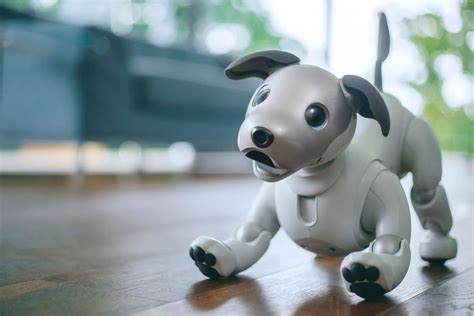Introduction
Artificial Intelligence (AI) is rapidly transforming various industries, and the pet industry is no exception. AI robot pets are gaining popularity as an innovative way to provide companionship and support pet owners while also addressing the challenges of traditional pet ownership. In this article, we will explore the fascinating world of AI robot pets, their potential benefits, and the emerging field of AI-powered pet training.

The Rise of AI Robot Pets
According to a 2023 study by Allied Market Research, the global robot pet market is projected to reach $3.1 billion by 2030. This surge in demand is driven by advancements in AI technology, increasing urbanization, and changing pet-owning trends.
Benefits of AI Robot Pets
AI robot pets offer several advantages over traditional pets, including:
- Convenience: AI pets do not require feeding, grooming, or veterinary care, making them ideal for busy individuals or those with limited space.
- Companionship: AI pets provide companionship and emotional support, reducing loneliness and isolation.
- Educational: AI pets can be programmed with educational content, fostering learning and development.
- Therapeutic: AI pets have the potential to improve mental and physical health by providing therapeutic benefits.
- Hypoallergenic: AI pets are an excellent option for individuals with allergies or sensitive skin.
AI-Powered Pet Training
AI is also transforming the way we train our furry companions. AI-powered pet training apps utilize machine learning algorithms to analyze behavior patterns, provide personalized feedback, and deliver tailored training plans. These apps offer:
- Improved Efficiency: AI algorithms identify areas for improvement, saving time and effort in the training process.
- Precision: AI analyzes data to provide highly specific feedback, ensuring accurate and effective training.
- Customization: AI-powered apps personalize training plans based on the individual pet’s breed, age, and temperament.
- Remote Access: Trainings can be conducted remotely, allowing pet owners to train their pets from anywhere.
Applications for AI Robot Pets and AI-Powered Pet Training
The potential applications of AI robot pets and AI-powered pet training are vast, including:
- Elderly Care: AI companions provide companionship and cognitive stimulation for seniors, reducing loneliness and improving well-being.
- Therapy and Rehabilitation: AI pets can assist in therapy sessions, providing emotional support and promoting physical activity.
- Education: AI-powered pet training apps help children develop responsibility, empathy, and cognitive skills.
- Veterinary Medicine: AI algorithms can analyze pet data to detect health issues early on, improving veterinary care.
- Pet Care Services: AI robots can assist pet care professionals, such as dog walkers and groomers, by automating tasks and providing additional support.
Inspirations for Innovation
To further advance the field of AI robot pets and AI-powered pet training, we can explore new applications and concepts, such as:
Companion AI: Develop AI pets that can engage in meaningful conversations, share experiences, and provide emotional support.
AI-Enhanced Training Devices: Design devices that combine AI algorithms with interactive training aids, offering immersive and personalized experiences.
Pet Health Analytics: Create AI systems that continuously monitor pet behavior and health data to predict and prevent health issues.
Virtual Pet Communities: Establish virtual communities where AI robot pets can socialize and interact with other pets and owners remotely.
Tables
| Table 1: Benefits of AI Robot Pets |
|—|—|
| Convenience | No feeding, grooming, or veterinary care required |
| Companionship | Provides emotional support, reducing loneliness |
| Educational | Can be programmed with educational content |
| Therapeutic | Improves mental and physical health |
| Hypoallergenic | Ideal for individuals with allergies |
| Table 2: Applications of AI-Powered Pet Training |
|—|—|
| Improved Efficiency | AI algorithms identify areas for improvement |
| Precision | Highly specific feedback ensures accurate training |
| Customization | Tailored training plans based on individual pet characteristics |
| Remote Access | Trainings can be conducted from anywhere |
| Table 3: Potential Applications of AI Robot Pets and AI-Powered Pet Training |
|—|—|
| Elderly Care | Companionship and cognitive stimulation |
| Therapy and Rehabilitation | Emotional support and physical activity promotion |
| Education | Development of responsibility, empathy, and cognitive skills |
| Veterinary Medicine | Detection of health issues early on |
| Pet Care Services | Automation of tasks and additional support |
| Table 4: Inspirations for Innovation |
|—|—|
| Companion AI | Conversational and emotionally supportive AI pets |
| AI-Enhanced Training Devices | Immersive and personalized training aids |
| Pet Health Analytics | Prediction and prevention of health issues |
| Virtual Pet Communities | Remote socialization and interaction |
Tips and Tricks
- Start with a simple AI robot pet to get a feel for the technology before investing in a more advanced model.
- Use AI-powered pet training apps consistently to track progress and maximize results.
- Consult with a veterinarian or certified pet trainer to ensure that AI training is suitable for your pet’s needs.
- Supervise AI robot pets and training sessions, especially with young children.
Why It Matters
AI robot pets and AI-powered pet training have the potential to revolutionize pet ownership by providing companionship, support, and training convenience that traditional pets cannot offer. These technologies can also address the challenges of urbanization, busy lifestyles, and pet allergies.
Benefits of Using AI Robot Pets and AI-Powered Pet Training
- Improved Pet Health and Well-being
- Reduced Loneliness and Isolation
- Enhanced Pet Training Efficiency and Accuracy
- Increased Pet Owner Convenience and Flexibility
- Potential Therapeutic and Educational Benefits
FAQs
- Are AI robot pets good for children? Yes, AI robot pets can provide companionship and educational benefits for children, but supervision is recommended.
- Can AI robot pets replace traditional pets? No, AI robot pets are not meant to replace traditional pets but rather provide an alternative or supplement.
- Are AI-powered pet training apps effective? Yes, AI-powered pet training apps have been shown to improve training efficiency and accuracy.
- Will AI eventually replace human pet trainers? No, AI will likely not replace human pet trainers but rather augment their abilities.
- What are the limitations of AI robot pets and AI-powered pet training? Limitations include limited emotional depth, reliance on technology, and potential for malfunction.
- How much do AI robot pets and AI-powered pet training apps cost? Costs vary depending on the features and complexity, but they can range from a few hundred to several thousand dollars.
- What are the ethical implications of AI robot pets? Ethical questions include the impact on pet-owner relationships, animal welfare, and privacy.
- How can I find a reputable AI robot pet or AI-powered pet training app? Research reviews, read testimonials, and consider recommendations from veterinarians or pet trainers.





















